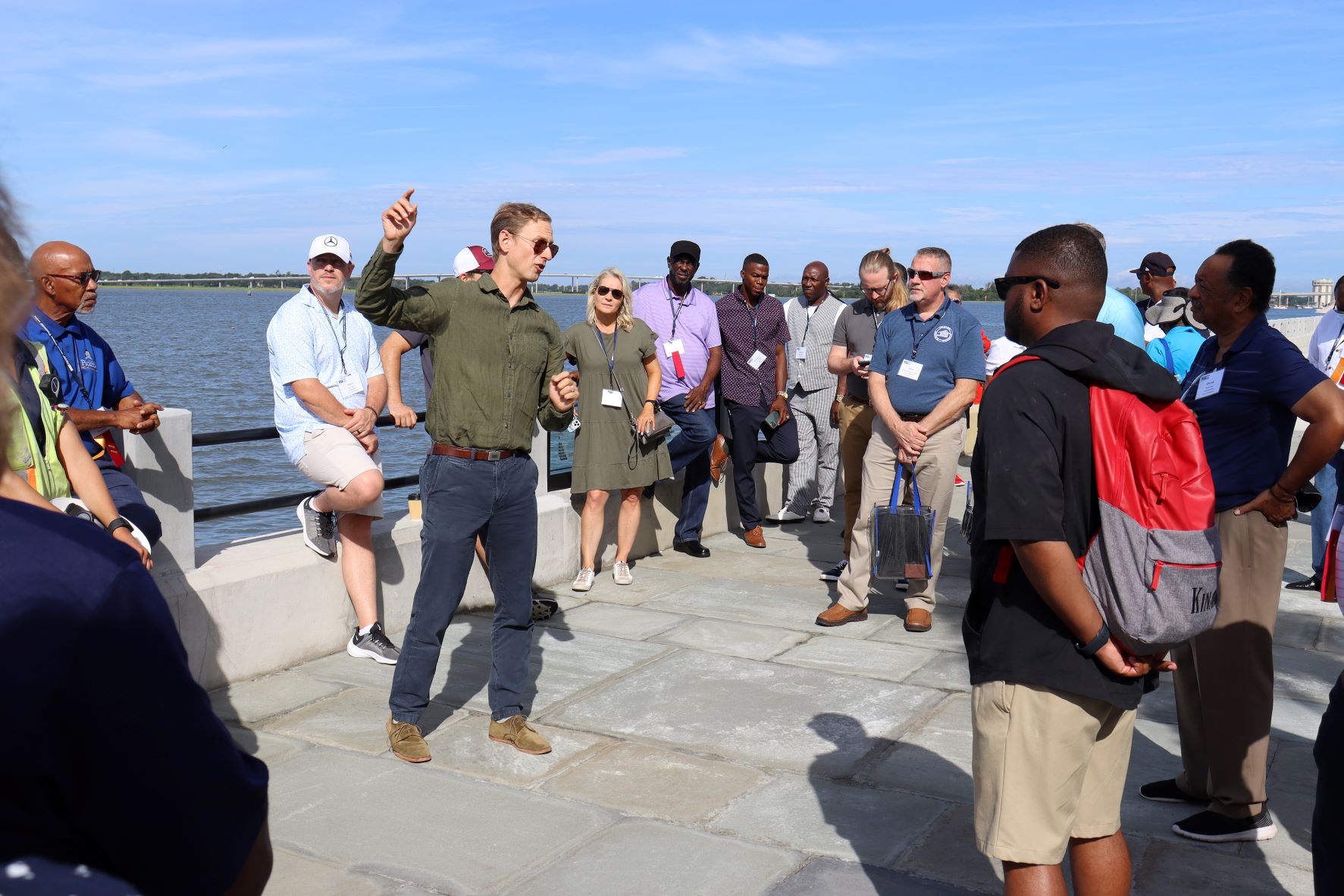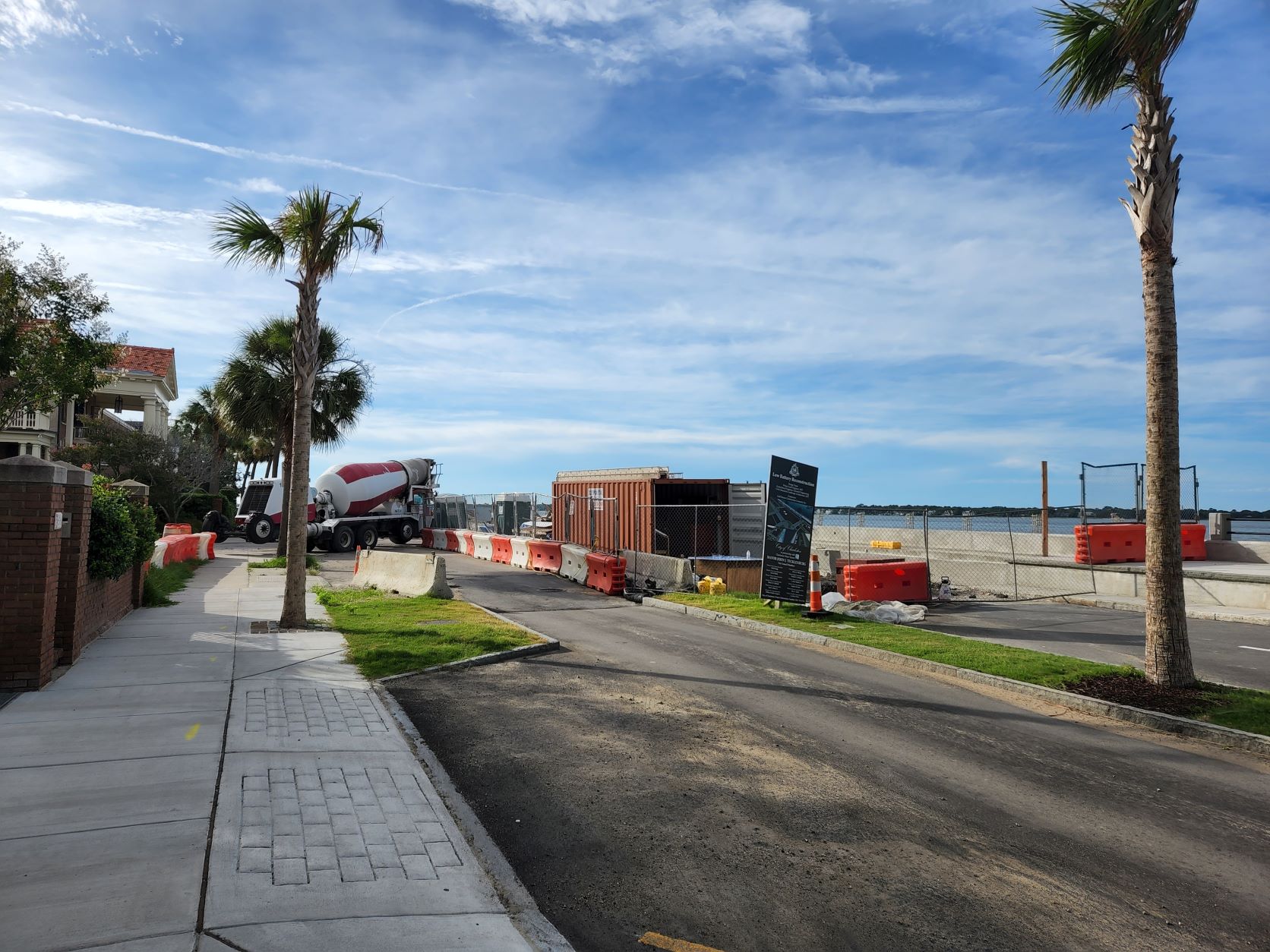The water is rising in Charleston Harbor, just as it is in many other places because of climate change. But sea level rise is not the only thing that has threatened the City of Charleston’s Low Battery seawall. Rain and storm surge events over the decades along with the simple aging of the early-20th-century infrastructure have created challenges and brought the seawall closer to structural failure.
The city responded to these threats with a multifaceted rebuilding project, addressing not only the structural needs but recreational opportunities and appearance concerns as well. The project became a showcase for a mobile tour during the Municipal Association of South Carolina’s Annual Meeting in July. Charleston’s Director of Stormwater Management Matthew Fountain presented alongside the Town of James Island’s Public Works Director Mark Johnson about the stormwater drainage improvements their municipalities created after collaborating.
Standing on the new Low Battery, two feet higher than the old one, and with construction still advancing in the distance, Fountain described the challenges presented by the original seawall construction in the early 20th century, which created more buildable land from what had been a marsh.
“They built a wall, and they built the ground right up to the point [where] it wouldn’t flood that day,” he said.
Rebuilding the seawall opened up the potential for handling many issues holistically, so the city could “leverage more things out of a single project,” Fountain said.

Charleston’s Director of Stormwater Management Matthew Fountain explains
the city’s Low Battery seawall repair project.
The project has gone far beyond addressing drainage capacity. It has also replaced water and sewer lines and rebuilt the street with traffic-calming devices. It expanded sidewalks, added handicapped accessibility, and even pursued new beautification with periodic bench-lined parklets. Fountain noted that the iconic Battery is part of a heavily-traveled recreation

corridor that connects the Cooper River Bridge to the place on the Ashley River where the city has been working on a pedestrian bridge.
“We tried to make this a very attractive project,” he said.
The area’s status as a tourism destination allowed for many millions of dollars of funding from accommodations and hospitality tax funding, but its importance to Charleston’s image also created many concerns about whether raising the seawall would detract from the city’s appearance. Fountain reported the project has been “incredibly well-received.”
“It’s one of the few projects I’ve ever worked on as a capital engineer that has almost no detractors,” he said, adding that even people who don’t live on the peninsula will still “run on it, bike on it, fish on it. People who live on the Battery are excited about how beautiful it looks.”

A portion of the City of Charleston’s historic low battery seawall receives upgrades
and an increase in height.
The bus tour also brought Annual Meeting attendees to James Island Town Hall, where Mayor Bill Woolsey called the guests’ attention to the native vegetation in the facility’s retention pond and bioswales, which are depressions that take in and filter stormwater. At the town hall, James Island’s Mark Johnson joined Michael Fountain in explaining the intergovernmental collaborations for drainage improvements.
In 2019, the City of Charleston joined with the Town of James Island and Charleston County for a wide-ranging drainage study, identifying drainage basins and prioritizing problem areas. Both municipalities updated their design standards manuals.
On James Island, the project’s main objective was to protect older homes from the drainage issues created by newer construction — a major issue in a region that has become known for its extreme land development pressure.
Johnson noted that new homes built as infill development tend to be built up higher, “so all the water goes to the neighbors. Then I get phone calls, and I don’t like getting phone calls like that.”
The updated design standards required offsite drainage impacts to be identified and managed. They aim for developers to work with the existing landscape and natural systems rather than against them, preventing or at least slowing down runoff — in the effort to keep stormwater under control, every minute and every gallon counts.
“Green infrastructure,” as Johnson noted, can be anything from rain gardens that retain water to filtration trenches or rain barrels.
“We’re going to start having classes for residents here at town hall so they can learn how to do these things,” he said. “We have most of the practices, right now, here that they can look at.”
Fountain noted that sudden summer thunderstorms have grown more disruptive over time in the Charleston region, especially when they combine with offshore winds pushing water into drainage systems, or the exceptionally high tides known as King Tides. These growing challenges have created much more intergovernmental collaboration to create solutions.
“I think one of the really big takeaways is that the town, the city, the county and [the SC Department of Transportation] have all gotten together and collaboratively said, ‘Let’s resolve drainage.’ Because water doesn’t know what jurisdiction it’s in. It crosses jurisdictions all the time,” he said.
